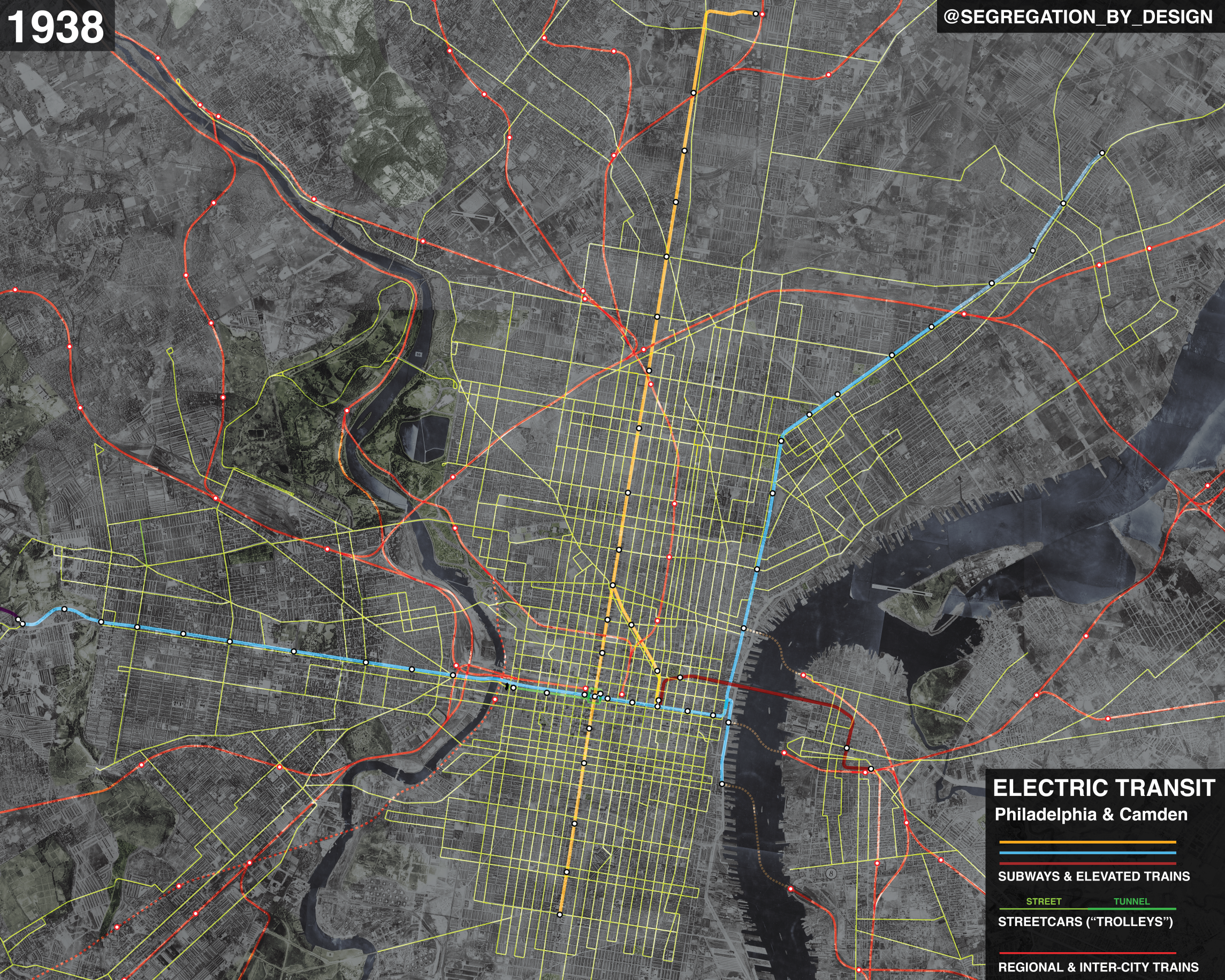PHILADELPHIA: TRANSIT
Unlike many of the cities covered, Philadelphia has retained and to some extent modernized much of its legacy rail infrastructure. However, like many of the other cities, Philadelphia followed flawed mid-century planning techniques which ultimately led to the reduction, dismantling, and de-electrification/dieselization of much of the network.
In general, electrified rail transit was another casualty of the federal government’s concerted effort to create a white, automobile-based suburbia. Whereas local transit systems had provided mobility within the city, the government had plowed its interstates through downtowns and urban neighborhoods in order to provide mobility OUT of the city—and to the racially-restricted suburbs. The freeways—for which the federal gov. at the time provided a whopping 90% federal funding match—were the literal routes of white flight, connecting with suburbs governed by “racial covenants,” prohibiting “persons of any race other than the Caucasian race” from living there.
The system that remained in Phil. had its focus shifted from primarily serving city-dwellers to instead primarily serving suburban commuters.
In addition to the widespread removal of the trolleys (which virtually eliminated high-quality local transit service in huge swaths of the city), this shift in focus is especially reflected in the regional rail network. First, many of the close-in, local stations were removed, such as Spring Garden and Girard Stations (seen in the second image) in the primarily-African American neighborhoods of North Phil. Close-in lines were cut back and had service reduced as the system switched to a more suburban focus.
Second, despite the fact that only 11% of commuters use regional rail, it receives nearly 40% of the SEPTA’s entire capital budget (a plurality). Moreover, the Consolidated City & County of Philadelphia (aka the city proper) contributes 83% of regional rail’s local operating subsidy, while the surrounding four suburban counties (where most regional rail stations are) contribute only 17%. In other words, the city is paying for suburban transit service at the expense of local service. Source @whyy
What investments have been made have only further solidified the system’s suburban shift. In the late 70s the city undertook the costly project of connecting the two stub end train terminals in Center City, Broad Street Station and Reading Terminal. While an excellent idea in theory (connecting the stations allowed for “through-running,” significantly increasing operational capacity), the project was executed and branded with a specifically suburban focus. Not only was the project itself known as the “Commuter Connection,” but also it led to the closure of local stations in nearby North Philadelphia, as well as ultimately a reduction in trackage (electrified trackage, no less) as the Reading viaduct was simply abandoned. Instead of capitalizing on the opportunities created by the city’s investment in the Commuter Connection and creating a Paris-like RER system with both local and suburban stations, SEPTA doubled-down on its suburban refocus and, again, actually eliminated many local stations.
Furthermore, strict zoning codes around suburban regional rail stations significantly restrict the potential ridership of the regional rail. Regular readers know that these zoning codes themselves of course have racist origins, and (as mentioned earlier) these suburbs were built with “restrictive covenants” that specifically prohibited people of color from purchasing, limiting the suburbs to “members of the caucasion race only.” Continued enforcement and maintenance of these zoning codes is nothing less than a continuation of the legacy of segregation.
Other than regional rail, the extension of PATCO from Market to its present terminus on 15th/Locust was also to some extent a gift to the suburbs. While not inherently a bad project, PATCO only has four stops in the city (plus one abandoned one at Franklin Square), two urban stops in Downtown Camden—followed by seven park-and-ride stations located in massive surface parking lots.



